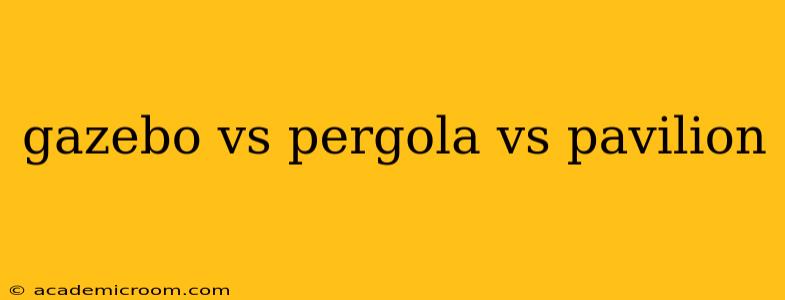Choosing between a gazebo, pergola, or pavilion can feel overwhelming. These outdoor structures all offer shade and a touch of elegance, but their distinct features cater to different needs and aesthetics. This comprehensive guide will clarify the key distinctions, helping you select the perfect structure to enhance your outdoor space.
What is a Gazebo?
A gazebo is a freestanding, usually octagonal or round, structure with a roof and often enclosed walls or latticework. Think of it as a small, charming garden house. Gazebos are designed to provide complete protection from the elements, offering shade, shelter from rain, and sometimes even protection from wind. They're typically more formal and ornate than pergolas or pavilions. Many gazebos include features like decorative trim, elegant roofing, and sometimes even built-in seating.
Key Features of a Gazebo:
- Freestanding structure: Not attached to a house or other building.
- Complete roof: Provides full protection from sun and rain.
- Often enclosed (partially or fully): Offers privacy and protection from the elements.
- Formal design: Usually features decorative elements and a more ornate style.
What is a Pergola?
A pergola is an open-roofed structure, typically attached to a house or wall, consisting of parallel beams supported by posts. It's more of a framework than a fully enclosed structure. Pergolas are primarily designed to provide shade and create a defined area within a garden or patio. They are often used to support climbing plants, adding a touch of natural beauty and further shade.
Key Features of a Pergola:
- Open roof: Offers partial shade, usually allowing sunlight to filter through.
- Attached or freestanding: Can be attached to a house or stand alone.
- Framework structure: Primarily consists of beams and posts.
- Ideal for climbing plants: Provides support for vines and other climbing plants.
- More informal design: Generally simpler and less ornate than gazebos.
What is a Pavilion?
A pavilion sits somewhere between a gazebo and a pergola in terms of structure and function. It can be freestanding or attached and often features a roof, although this can be partial or complete. Pavilions are more versatile than gazebos, offering a wider range of styles and designs. They might be as simple as a covered area with four posts and a roof, or they might be more elaborate, including walls or latticework.
Key Features of a Pavilion:
- Versatile design: Can range from simple to elaborate.
- Roof can be open or closed: Offers varying degrees of protection from the elements.
- Freestanding or attached: Provides flexibility in placement.
- Can incorporate various materials: Wood, metal, fabric, etc.
Gazebo vs. Pergola vs. Pavilion: Which is Right for You?
The best choice depends entirely on your needs and preferences:
- Need complete weather protection? A gazebo is your best option.
- Want a simple structure to support climbing plants and provide partial shade? A pergola is ideal.
- Looking for something versatile with customizable features? A pavilion offers the most flexibility.
Consider the following factors:
- Budget: Gazebos tend to be the most expensive, followed by pavilions, then pergolas.
- Space: Gazebos require more space than pergolas.
- Aesthetic: Choose a style that complements your home and garden.
- Maintenance: Wood structures require more maintenance than metal ones.
What is the difference between a gazebo and a pergola?
The primary difference lies in the roof. A gazebo has a complete roof, offering full protection from the sun and rain. A pergola, on the other hand, has an open roof, providing partial shade and allowing sunlight to filter through. Gazebos are generally more enclosed and formal, while pergolas are more open and informal.
What is the difference between a pergola and a pavilion?
The difference is often subtle. A pergola is essentially a framework, primarily designed to support climbing plants and provide some shade. A pavilion can be more substantial, often featuring a roof (though it might be partially open), walls, or latticework, offering a more enclosed space. Pavilions provide a wider range of design options and levels of protection from the elements.
Which is better, a gazebo or a pavilion?
This depends on your priorities. A gazebo offers complete weather protection and a more formal aesthetic. A pavilion provides more versatility, allowing for a wider range of styles and levels of enclosure. If weather protection is paramount, choose a gazebo. If flexibility in design is key, a pavilion might be the better choice.
By carefully considering these factors and the unique features of each structure, you can confidently select the perfect gazebo, pergola, or pavilion to enhance your outdoor living space. Remember to factor in your budget, available space, personal style, and desired level of weather protection.
